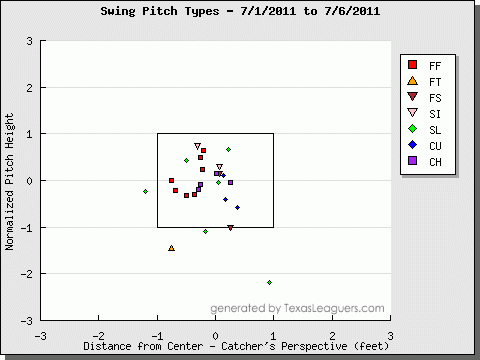Through the first 20 games in his short career, some pundits were already labeling Tsuyoshi Nishioka a “bust” and a “mistake” by the Twins front office. There were little indications that he would be someone who could handle playing at the highest level of professional baseball. Defensively, he played like with the jitteriness of someone on 27 cups of caffeinate crack while offensively, major league pitchers – particularly those of the right-handed variety – were chewing him up and spitting him out.
Perhaps because of JJ Hardy’s thunderous performance with his new team or Trevor Plouffe’s continued decimation of International League pitching, scrutiny over Nishioka’s lack of offensive contributions has taken center stage. While his numbers are still depressing, there is evidence that he might be capable for turning things around.
In the beginning of the season, Nishioka’s one-foot-out-of-the-box style of hitting from the left-side was easily defused by a steady stream of pitches on the outer-half of the plate. Scouts clearly saw this flaw in his game and opponents went to work exploiting this weakness:
Tsuyoshi Nishioka’s Pitch Location (Left)
| ||
Inside
|
Middle
|
Away
|
22
|
51
|
139
|
14%
|
23%
|
63%
|
(data from joelefkowitz.com)
With his momentum taking his body towards first, the switch-hitting infielder could do little but dribble and doink the deluge of fastballs and off-speed pitches with minimum oomph. Below is a prime example of this in action. The Giants’ Ryan Vogelsong runs a fastball down and away which Nishioka – whose weight is already moving towards first base when contact is made – bounces it innocuously enough to short:

After several weeks of watching this transpire, at the end of June, manager Ron Gardenhire had enough of Nishioka’s left-handed approach:
"He drifted off the ball again tonight. He's got to stay there. He can't drift off like that."
Helpless at the plate, with the language barrier - in addition to a technology barrier – the Twins seemed to have their own internal issues attempting to communicate with the scuffling rookie. Despite all of the obstacles, it appears that the team has found a way to get the message through to Nishioka. Not long after that, Nishioka appears to have made two changes that have provided the team with some reassuring signs of progress.
Posted in Joe Christensen’s Around the Majors blog, Amelia Rayno and Alex Prewitt wrote that Twins hitting coach, Joe Vavra, had provided the shortstop with some psychological and mechanical tips – the latter of which Nishioka did not care to divulge. In spite of the secrecy, after watching him since the Rays series and from consulting the recent clips of his swing compared to earlier cuts, we find that from the left-side of the dish, Nishioka has made an alteration that should help improve his overall coverage.
Here is a clip from April:

Compare that to last night’s swing:

In the first clip at Yankee Stadium, you see Nishioka swinging his front leg open more, planting the right foot towards the first base line. This motion already sets him up for struggles when being pitched away – and that is before the problems piled on when the rest of his body begins to drift off toward that direction in mid-swing. The second clip of Nishioka’s single back up the middle last night shows him striding and planting his lead foot towards the pitcher, keeping his front-side in more. This gives him the capacity to cover the entire plate. After all, look how much closer he ends up at the plate in comparison to the above clip in San Francisco.
The second change in what is a giant step forward for the rookie is his drastic reduction in the amount of pitches chased on the outer-half. While pitchers are still trying to work him away, Nishioka has begun to lay off those extremely tough pitches just off the plate.
The charts below show the location of the pitches Nishioka has swung at (viewed from a catcher’s perspective). What we see is that from April through June (top chart), Nishioka offered at plenty of the pitches on the far side of the zone. While those pitches are within the strike zone, they are very difficult pitches to hit well – a “pitcher’s pitch” as Bert would say. Since the beginning of July (bottom chart), he has refrained from swinging at those pitches.


In essence, Nishioka has made improvements twofold. The first being the mechanical adjustment that allows him to cover the zone better. As noted above, he is driving toward the pitcher more with his weight and has effectively increased his plate coverage. The second is that he is simply recognizing which pitches he can and cannot handle. So while he may be able to put that fastball on the black into play, the results are not likely going to be favorable. Taking that pitch is a much better decision.
This could be a significant turning point in Nishioka’s development in his first season stateside. He still has a long ways to go in order to become one of the “better shortstops in the American League” as his former Chiba Lotte executive predicted, but Nishioka is at least back on the right path.
- Now available at DiamondCentric for a pre-sale price of $15.99:
- The National Parkinson Foundation of Minnesota has a great offer for Twins fans that can help the foundation. Bert Blyleven’s favorite foundation is offering tickets to an upcoming Twins/Royals game on July 16th. It also happens to be the day his number “28” gets retired. For $24, fans get a seat in section 329 with the proceeds going to support Parkinson’s research. You can find more information on the organization and purchase your ticket here.


No comments:
Post a Comment